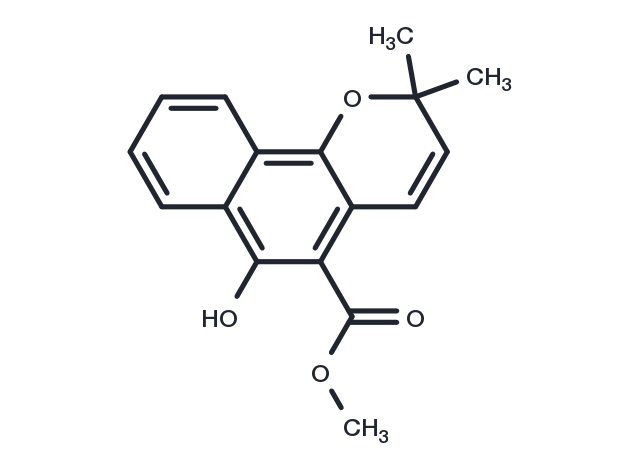Powder: -20°C for 3 years | In solvent: -80°C for 1 year


Mollugin (Rubimaillin) may be a JAK2 inhibitor and inhibits LPS-induced inflammatory responses by blocking the activation of the JAK-STAT pathway. Mollugin as a candidate for a chemotherapeutic agent in OSCCs via the upregulation of the HO-1 and Nrf2 pathways and the downregulation of NF- κ B. Mollugin may be a novel therapeutic candidate for bone loss-associated disorders including osteoporosis, rheumatoid arthritis, and periodontitis. Also, it has anticancer efficacy, can modulate the HER2 pathway in HER2-overexpressing Y cells with a potential role in the treatment and prevention of human breast and ovarian Y with HER2 overexpression.

| Pack Size | Availability | Price/USD | Quantity |
|---|---|---|---|
| 5 mg | In stock | $ 39.00 | |
| 10 mg | In stock | $ 72.00 | |
| 25 mg | In stock | $ 128.00 | |
| 50 mg | In stock | $ 198.00 | |
| 100 mg | In stock | $ 297.00 | |
| 500 mg | In stock | $ 733.00 |




| Description | Mollugin (Rubimaillin) may be a JAK2 inhibitor and inhibits LPS-induced inflammatory responses by blocking the activation of the JAK-STAT pathway. Mollugin as a candidate for a chemotherapeutic agent in OSCCs via the upregulation of the HO-1 and Nrf2 pathways and the downregulation of NF- κ B. Mollugin may be a novel therapeutic candidate for bone loss-associated disorders including osteoporosis, rheumatoid arthritis, and periodontitis. Also, it has anticancer efficacy, can modulate the HER2 pathway in HER2-overexpressing Y cells with a potential role in the treatment and prevention of human breast and ovarian Y with HER2 overexpression. |
| Source |
| Synonyms | Rubimaillin |
| Molecular Weight | 284.31 |
| Formula | C17H16O4 |
| CAS No. | 55481-88-4 |
Powder: -20°C for 3 years | In solvent: -80°C for 1 year
DMSO: 20 mg/mL(70.3 mM)
Chloroform, Dichloromethane, Ethyl Acetate, Acetone: Soluble
You can also refer to dose conversion for different animals. More
bottom
Please see Inhibitor Handling Instructions for more frequently ask questions. Topics include: how to prepare stock solutions, how to store products, and cautions on cell-based assays & animal experiments, etc.
Mollugin 55481-88-4 Angiogenesis Chromatin/Epigenetic JAK/STAT signaling Stem Cells Tyrosine Kinase/Adaptors JAK HER NF-κB c-Myc Nuclear factor-kappaB Inhibitor inhibit Apoptosis HEK293 H22-tumor HepG2 cells Vascular endothelial growth factor receptor VEGFR Reactive Oxygen Species ROS HeLa antitumor Liver cancer Hep3B Myc DNA damage Rubimaillin anti-hepatocellular Nuclear factor-κB inhibitor
